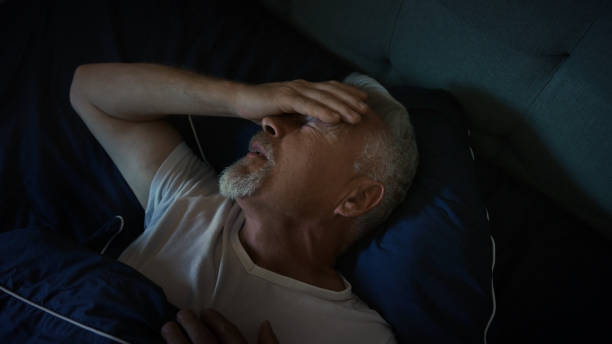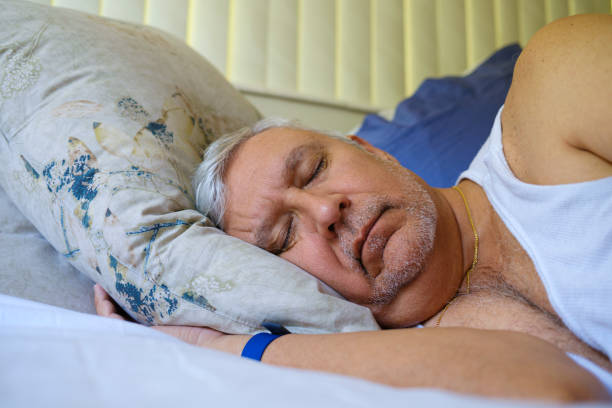Introduction

Parkinson's disease is a neurodegenerative disorder affecting millions worldwide, causing a range of motor and non-motor symptoms. Recent research has shed light on a fascinating connection between breathing patterns during sleep and the manifestation of Parkinson's disease symptoms. While traditionally associated with motor impairments, Parkinson's symptoms can also extend to breathing difficulties, particularly at night.
This blog post explores the connection between breathing patterns during the night and symptoms of Parkinson's disease. It examines what this finding means for patients and healthcare professionals. Join us as we unravel the intricate relationship between sleep-related breathing abnormalities and the progression of Parkinson's disease.
What are Night Breathing Patterns?

Night breathing patterns, also known as sleep-disordered breathing (SDB), are changes in the normal pattern and quality of breathing during sleep. There are different types of SDB, including obstructive sleep apnea (OSA) and central sleep apnea, which can disrupt the normal sleeping cycle, causing fatigue and other symptoms such as headaches.
How Can Night Breathing Patterns Affect Parkinson's Disease?
The human body's ability to control movements and regulate bodily functions is affected by Parkinson's disease, a neurodegenerative disorder that worsens over time. Tremors, slowed movement, rigidity, impaired balance, and difficulty with walking and speech characterize it. One lesser-known symptom of Parkinson's disease is changes in night breathing patterns.
The primary cause of sleep-related breathing disorders in Parkinson's patients is the reduced ability to control muscles responsible for normal breathing patterns during sleep. As a result, individuals may experience difficulty breathing while asleep, leading to disrupted sleep and decreased overall quality of life.
Studies have found that people with PD are more likely than those without PD to have obstructive sleep apnea (OSA) or other forms of sleep-disordered breathing (SDB). OSA occurs when air cannot flow through the upper airway due to blockages, whereas SDB can cause various physiological symptoms, including snoring, breathing pauses, and difficulty breathing.
In addition to OSA and SDB, PD patients may experience irregular breathing patterns throughout the night. These include periods of breath-holding (apneas) or frequent awakenings due to breathing problems or other sensations. Sometimes, a person with PD may have difficulty initiating respiration while sleeping.
Poor sleep quality can worsen motor symptoms in PD and lead to a decline in cognitive function. In addition, research indicates that individuals who experience irregular breathing during sleep may have an increased risk of developing Parkinson's disease.
A study discovered that individuals who snore moderately to severely have a greater than two-fold likelihood of developing PD compared to those who do not snore. Additionally, the researchers found that breathing disturbances, such as apneas, can increase the risk of developing PD by up to five times.
Importance of understanding night breathing patterns in Parkinson's disease

Understanding the link between night breathing patterns and Parkinson's disease symptoms is crucial to developing preventative strategies for those suffering from this debilitating neurological disorder. People with Parkinson's disease experience instability of sleep-wake cycles and changes in their breathing patterns, which can lead to serious health complications.
By better understanding the relationship between nighttime breathing patterns and the symptoms of Parkinson's disease, clinicians and researchers can develop more effective treatments for those who suffer from this condition.
This guide explains the relationship between breathing patterns during sleep and Parkinson's disease.
1. Identify Symptoms:
To comprehend the link between Parkinson's disease and nighttime breathing patterns, we must first recognize the symptoms of Parkinson's. Common symptoms of Parkinson's include tremors, bradykinesia (slowness of movement), and rigidity.
2. Monitor Breathing Patterns:
Once the symptoms have been identified, monitoring breathing patterns throughout the night is important to observe any abnormalities. In people with Parkinson's disease, nighttime hypopnea (shallow breathing) and apneas (momentary cessations of breath) can occur more frequently than in individuals without the condition.
3. Consult a Medical Professional:
If you suspect that your night breathing patterns could be related to Parkinson's disease, it is important to consult a medical professional. Your doctor can conduct tests to accurately diagnose the condition and recommend appropriate treatments.
4. Address Night Breathing Issues:
If hypopnea or apneas are determined to be related to your Parkinson's disease symptoms, it is important to address this issue promptly. Treatment options may include CPAP (continuous positive airway pressure) therapy, oral appliances, lifestyle modifications, and behavioral strategies.
5. Research Treatment Options:
Research the available treatment options to better understand their efficacy in managing night breathing issues related to Parkinson's disease. We that you seek advice from your doctor to learn more about the advantages, disadvantages, expenses, and accessibility of these treatments.
6. Consider Alternative Therapies:
In addition to traditional treatment options, explore alternative therapies that may help alleviate night breathing issues in people with Parkinson's. These may include yoga, meditation, massage, and acupuncture. Before trying, talk to your healthcare provider about these therapies' possible benefits and risks.
7. Consider a Sleep Apnea Diagnosis:
If you have night breathing issues related to your Parkinson's disease, getting a sleep apnea diagnosis is important. This will aid in identifying the reason behind your night breathing and determining the optimal treatment method.
Based on the test outcomes, you may receive recommendations for lifestyle changes or medical treatments to alleviate symptoms and enhance your overall well-being.
What are the breathing difficulties faced by Parkinson's patients during sleep?
Breathing difficulties during sleep can be common among individuals with Parkinson's disease. These difficulties can significantly impact sleep quality and patients' overall well-being. Some of the specific breathing challenges faced by Parkinson's patients during sleep include:
Sleep Apnea:
Sleep apnea is when breathing constantly stops and restarts during sleep. Parkinson's patients may have a higher risk of developing sleep apnea due to muscle stiffness and impaired coordination associated with the disease. These factors can cause the airway to become narrow or blocked, leading to interrupted breathing patterns.
Respiratory muscle weakness:
Parkinson's disease can cause weakness in the muscles involved in breathing, making it more difficult for patients to take deep, satisfying breaths during sleep. This weakness may contribute to shallow breathing and reduced airflow, leading to breathing difficulties and potential oxygen deprivation.
Rapid Eye Movement (REM) Sleep Behavior Disorder:
During REM sleep behavior disorder, individuals act out their dreams during the REM sleep phase. Parkinson's patients with this disorder may experience abnormal breathing patterns, such as hyperventilation or irregular breathing, while they act out their dreams.
Hypoventilation:
Parkinson's disease can affect the automatic control of breathing, leading to a decreased drive to breathe during sleep. This can result in hypoventilation, where the individual fails to take in enough oxygen or eliminate enough carbon dioxide. Hypoventilation can cause excessive sleepiness, morning headaches, and fatigue.
Medication Side Effects:
Some medications commonly used to manage Parkinson's symptoms can have side effects that affect breathing. For instance, certain dopamine agonists can potentially cause respiratory difficulties during sleep.
Individuals with Parkinson's disease and their caregivers must know about these breathing difficulties during sleep and seek medical evaluation and appropriate interventions. Healthcare professionals can provide tailored treatment options such as continuous positive airway pressure (CPAP) devices, positional therapy, medication adjustments, or referrals to sleep specialists to manage and improve breathing difficulties during sleep.
Sleep hygiene tips for Parkinson's patients
Here are some tips people with Parkinson's can use to improve their sleep hygiene.
-
For better sleep, maintain a regular sleep schedule every day, even on weekends and holidays. This means going to bed and waking up simultaneously every day. You can take a nap, but only for 30 minutes, and take it during the early afternoon.
-
Taking a brisk walk or doing light exercises can help, but don't exercise too close to bedtime, or it may make it harder for you to fall asleep.
-
Both activities can interfere with sleep, so avoid engaging in either after lunchtime.
-
Consuming food close to bedtime can interrupt your sleep as it can make your digestive system active, leading to frequent awakenings during the night.
-
To improve your ability to fall asleep, try calming activities such as taking a warm bath, reading, or doing gentle stretches for an hour before bed. A regular sleep schedule can enhance your capacity to fall asleep and remain asleep for extended periods as your body becomes accustomed to the routine.
-
Consider creating a relaxing atmosphere in your bedroom to make it easier to fall asleep. This includes ensuring the room's temperature is cool, keeping the lights dim or off, and avoiding screens before bed.
FAQ's
How does Parkinson's cause sleep apnea?
Parkinson's disease affects the nerve pathways that control muscle movement, including breathing. This can lead to changes in respiratory patterns during sleep, resulting in obstruction of the airways and difficulty breathing. Although the exact cause is unknown, sleep apnea is a common sleep-related issue associated with Parkinson's disease.
Can Parkinson's cause low oxygen?
If you have Parkinson's, the changes in your breathing can cause a drop in your oxygen levels. This can result in tiredness during the day, fatigue, heart problems, and cognitive decline. It's crucial to talk to a doctor about your symptoms and frequently check your oxygen levels.
What is the most common cause of death for people with Parkinson's?
Pneumonia is the primary cause of death for individuals with Parkinson's disease. Due to the risk of aspiration pneumonia related to swallowing difficulties, and weakened chest muscles, people with this condition may experience breathing difficulties leading to fluid accumulation in the lungs and, ultimately, pneumonia. Moreover, certain Parkinson's medications can hinder the coughing reflexes necessary to eliminate lung bacteria. Hence, discussing breathing difficulties with a doctor and taking preventive measures like regular chest exercises is crucial.
What is the average age of death for Parkinson's patients?
On average, people with Parkinson's disease pass away at the age of 81.7 years. However, some can live much longer if the disease progresses more slowly. Also, many individuals may die from conditions related to Parkinson's but not directly caused by it. Individuals with Parkinson's may have weakened breathing muscles and swallowing difficulties, potentially increasing their susceptibility to respiratory infections such as pneumonia.
How long is the final stage of Parkinson's disease?
The final stage of Parkinson's is typically the longest and can last several years. During this stage, people with Parkinson's may experience severe mobility issues, difficulty speaking or swallowing, cognitive deficits, fatigue, depression, and more. Treatment options are limited during this stage, and the focus is on providing comfort and managing symptoms.
What is the advanced stage of Parkinson's disease?
The advanced stage of Parkinson's is marked by significant physical and cognitive decline. Mobility is severely impaired, and the individual may be unable to walk or even feed themselves independently. In this stage, speech is often restricted to only a few words or phrases that may repeat themselves, if the person can speak. Memory loss, confusion, and disorientation are also prevalent.
Conclusion
In conclusion, understanding the link between nighttime breathing patterns and Parkinson's disease symptoms is essential for early detection and intervention. Detecting and treating Parkinson's disease in its early stages can substantially enhance the individual's quality of life and decelerate the progression of the ailment. By monitoring nighttime breathing patterns, doctors can detect signs of sleep apnea or other related conditions that could exacerbate Parkinson's symptoms or even cause them. With this knowledge, patients can receive earlier and more targeted treatments to help manage their condition. This knowledge will lead to better care for those with Parkinson's disease and improved overall quality of life.

